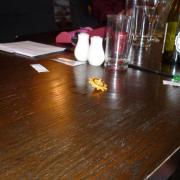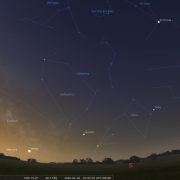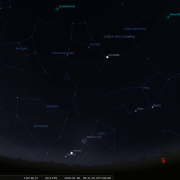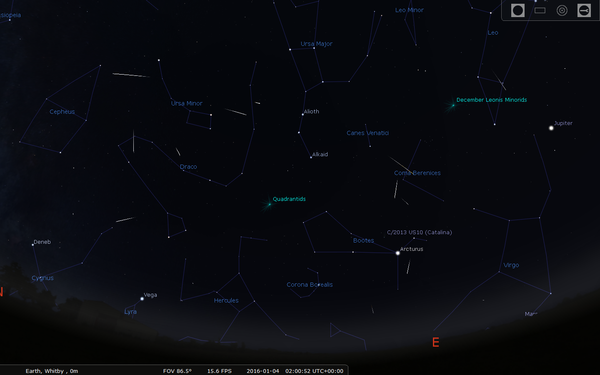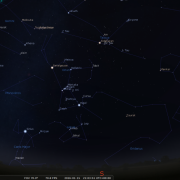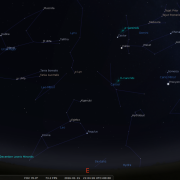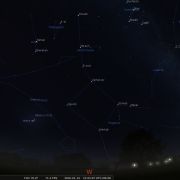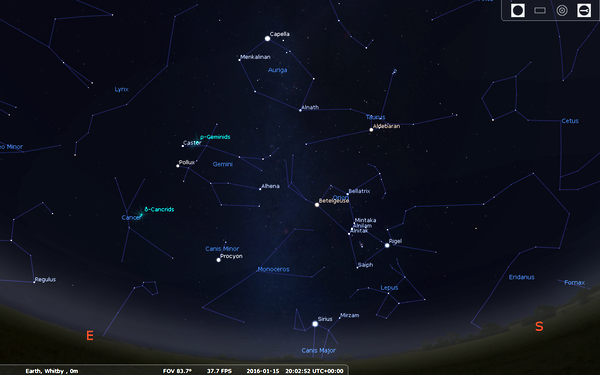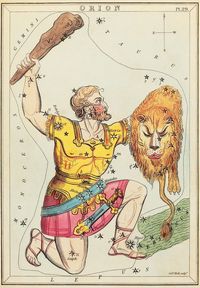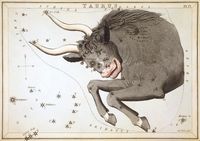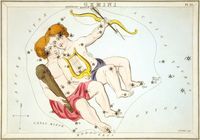Welcome to the WDAS monthly newsletter for January 2016: a digest of the month's latest contributions to our website. Below you'll find Society News, Sky Notes and In-Focus articles printed in full. There's also future events, and trailers for other articles which appear in full on the website - just a click away!
On the website you'll also be able to comment on articles, and if you'd like to play an editorial role in creating new content, just let us know!
Quick Summary for January:
- WDAS Society Meeting on Tuesday 1st December from 19:30h, including a talk on Volcanoes of the Solar System.
Society News
A long time ago (about a year actually) in a galaxy far, far away, (truth be told it was really quite close, like this one) a party of intrepid rebels ventured forth to eat and be merry.

Such a good time was had by all; they swore (language Timothy!) to return when the time was ripe. That day dawned, oops! And dawned again the following day, when once again society clans came together to feast and draw up plans for the adventures ahead. The rendez-vous place was the extremely wind-swept hamlet of Hawsker in the local watering hole known as the Hare & Hounds. The shuttle missions bringing various parties to the location successfully avoided any imperial fighters and storm troopers, but not the storm – did I mention the wind. Once inside however, all was cosy and welcoming, the venue droids being most attentive. The festive food was excellent, washed down with a few bottles of the local moonshine, much to the liking of our rebel party.
However all this was just a cover for the real intention of the meeting; to formulate a plan to bring down the empire. For this purpose secret devices had been cunningly concealed within the party crackers, undetected by the dark side. Once pulled (crack) these devices, resembling trinkets and toys, were used to demonstrate how the precessing spin of our secret weapon, (identified by a spinning top) coupled with the laws of the conservation of angular momentum, could be used to jettison the Deathstar (a marble) away from neighbourhood of any planet.

The plan was greeted with universal approval by all factions and will be implemented as soon as we have enough ‘small teddy bears’ to help distract the forces of the empire.
All too soon it was time to seek out our own lands, and after handing over the correct bounty (for once) we slipped away undetected (these are not the droids we are looking for).
Time will tell if the plans drawn up worked – we shall come together in another 366 revolutions. Until then thanks to all those rebel parties attending; live long and prosper. Yes I know that’s from a different franchise.
Sky Notes
In this month's Sky Notes:
Planetary Skylights

 Elusive Mercury may be glimpsed during the first and last week of January. Look for it as the New Year begins low above the South-West horizon from 16:15 to 16:40h. It will then drop from view only to reappear as a morning object just above the South-East horizon to the lower left of Venus around 07:00h during the last few days of January and into February. You will require a clear unobstructed horizon in order to locate it, look for fairly bright star in the twilight a binocular field above the horizon.
Elusive Mercury may be glimpsed during the first and last week of January. Look for it as the New Year begins low above the South-West horizon from 16:15 to 16:40h. It will then drop from view only to reappear as a morning object just above the South-East horizon to the lower left of Venus around 07:00h during the last few days of January and into February. You will require a clear unobstructed horizon in order to locate it, look for fairly bright star in the twilight a binocular field above the horizon.

 Conspicuous Jupiter is rising before midnight at the start of January before coming to dominate the late evening sky over in the east by the end of the month. However it should still primarily be considered an early morning object, and a fine one at that! Viewed through a telescope, look for the banding across the disk and the Galilean moons, visible as specks of light nearby. The Moon lies nearby on the 27th.
Conspicuous Jupiter is rising before midnight at the start of January before coming to dominate the late evening sky over in the east by the end of the month. However it should still primarily be considered an early morning object, and a fine one at that! Viewed through a telescope, look for the banding across the disk and the Galilean moons, visible as specks of light nearby. The Moon lies nearby on the 27th.

 As the New Year commences Mars, Venus and Saturn all reside in the dawn sky – lower left of Jupiter. The orange hue of Mars lies to the left of white Spica (chief star in Virgo). Brilliant Venus resides lower left of Mars, not that far above the South-East horizon.
As the New Year commences Mars, Venus and Saturn all reside in the dawn sky – lower left of Jupiter. The orange hue of Mars lies to the left of white Spica (chief star in Virgo). Brilliant Venus resides lower left of Mars, not that far above the South-East horizon.
The highlight of the month is an extremely close conjunction of Venus and Saturn on the 9th View around 07:00h, when to the naked eye they will appear exceptionally close. Even through a scope at low power they may both appear in the same field of view. Venus will exhibit a waning crescent phase. Saturn will be a glorious spectacle with the ring system wide open, with Titan nearby. As the month progresses Venus drops out of view
The Moon passes through the dawn sky close to the morning planets from the 3rd to the 7th.
Watch, as the moon occults several members of The Hyades star cluster (including Aldebaran, the ‘fiery eye’ of Taurus-the Bull) over the night of the 19/20th The Hyades is the ‘V’ shaped cluster in Taurus.
 Earth reaches perihelion (closest to the Sun) on January 2nd at 23:00h UT some 147 million km (91.73 million miles) from our nearest star.
Earth reaches perihelion (closest to the Sun) on January 2nd at 23:00h UT some 147 million km (91.73 million miles) from our nearest star.
New Year Meteors

The year starts with one of the more prolific meteor showers, the Quadrantids, active between Jan 1- 6th The short lived shower peak normally falls in the early hours of the 4th, around 02:00-04:00h, one reason it is often missed by observers.
Peak zenith hourly rates may exceed 80 per hour, but observers usually see 25-40 per hour. Quadrantids appear to radiate from the now defunct constellation of Quadrans Muralis, which was removed from sky charts in 1922, but used to lie at the junction between Hercules, Bootes and Ursa Major. This position in the sky is located low to the North at the time of the peak, so view in any direction this one.
January 2016 Sky Charts
Click each image to see a full-size Sky Chart:
|
Looking South
Mid January - 21:00h |
Looking North |
|
Looking East
Mid January - 21:00h |
Looking West
Mid January - 21:00h |
|
|
|
|
Overview
Mid January - 21:00h |
|
Additional Image Credits:
- Planets and Comets where not otherwise mentioned: NASA
- Sky Charts: Stellarium Software
In-Focus
One of the most impressive stellar panoramas is the jewelled canopy of the winter night sky, in particular the southern aspect, adorned as it is with imposing constellations and studded with an array of brilliant stars. Rich in both mythology and observational interest, there is plenty here to reward an observer, whether using binoculars, a telescope or just the naked eye.
Standing at the heart of this glittering tableau is the mighty hunter, Orion, located to south during mid January evenings. The main outline is quite distinct, a sloping line of 3 stars set in the midst of a larger stellar rectangle. Two of these stars, in opposing corners, are real super luminaries’. Searing blue/white Rigel illuminates the bottom right, a star perhaps 60-70,000 times more luminous than our Sun. Opposite Rigel, in the “red corner” (top left) lies Betelgeuse, an orange super-giant with “one foot in the stellar grave”. Betelgeuse is truly gargantuan, over 400 million miles in diameter. Put another way, if Betelgeuse were at the heart of our solar system it would extend out beyond the orbit of Mars! Of all the naked eye stars visible in the night sky, Betelgeuse is possibly the strongest candidate to end its days as a supernova, tearing itself apart in a cataclysmic explosion that will light up the sky for weeks on end. Will it be in our lifetimes- who knows? We do know however that in a few tens of millions of years Rigel will also follow suit.
Situated a little way below the three stars marking Orion’s belt is one of the heavens great show piece objects. Seen clearly as a misty smudge through binoculars, the Orion nebula is the nearest region of stellar birth, estimated to be a little over 1200 light years away. The Nebula consists of a huge cloud of gas and dust in which new stars are “born”. Telescopically the nebula breathtaking, a swirl of nebulous cloud at the heart of which reside the Trapezium stars, the four “bully boys” of this stellar crèche little more than 10 million years old.
Bearing down on Orion to his upper right is Taurus the Bull, whose eye is marked by fiery hued Aldebaran in the ‘V’ shaped Hyades star cluster, although it is not a true member. A little further west, the Pleiades star cluster (Seven Sisters) is an exquisite sight through binoculars or very low power eyepiece of a telescope. Riding high to the south and above Taurus are the stars of the charioteer - Auriga, highlighted by bright Capella located almost overhead.
Upper left of Orion stand the Twins of Gemini, marked by the two conspicuous stars, Castor and Pollux. Castor, the most northerly of the pair, is slightly fainter than twin brother Pollux which shines with a pale amber lustre. Although Castor appears solitary, in reality it is a multiple system of which the brightest two components may be separated in a modest scope, given stable atmospheric conditions.
Two hunting dogs, Canis Major and Canis Minor, accompany Orion, dutifully following their master across the heavens. Canis Major is overwhelmed by the sparkling presence of Sirius, the brightest star in the entire night sky. The lesser dog, Canis Minor is also distinguished by a conspicuous star- Procyon, located left of Orion and below Gemini. The prominence of both stars is down to proximity; 8.6 and 11 light years respectively. The dog’s quarry, the timid celestial hare of Lepus, may be traced crouching below Orion and above the southern horizon. Forever separating master and greater dog from the lesser one, look for the faint glow of the winter Milky Way which passes down to the left of Orion.
No matter whether you are an experienced observer, or perhaps have just acquired a pair of binoculars or a telescope, the jewels of Orion and his retinue are a joy to explore time and time again. Wrap up well, find somewhere dark and enjoy!
Image Credits:
- Constellation Images: a set of constellation cards called Urania's Mirror, published in London c.1825.
Hope you all managed to watch UK astronaut Tim Peake safely reach the ISS. Whether you caught it live on the news, or the Stargazing Live Special, i thought the coverage was quite extensive and actually rather tense and exhilarating.

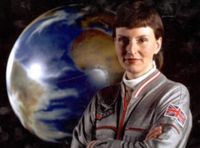 Of course Major Tim is not the first Britain in space, that honour went to Helen Sharman in 1991 who had secured private funding with the Russian government and spent a week on Mir. Other ‘space brits’ have dual citizenship and have flown under the American flag. These include Piers Sellers, Nicholas Patrick and Greg Johnson. The most experienced British-born astronaut is Michael Foale, who was turned down twice before being accepted as a Nasa astronaut. Foale has missions to the Mir station and the ISS under his belt. Finally, British-born games developer Richard Garriott followed in the footsteps of his father, Nasa astronaut Owen Garriott, and travel to the ISS on a Russian rocket in 2008. Major Tim Peake is however the first British astronaut to be funded by the taxpayer (you and me) and as such his stay on the ISS is being used to promote ‘the sciences and engineering’’ at schools and colleges.
Of course Major Tim is not the first Britain in space, that honour went to Helen Sharman in 1991 who had secured private funding with the Russian government and spent a week on Mir. Other ‘space brits’ have dual citizenship and have flown under the American flag. These include Piers Sellers, Nicholas Patrick and Greg Johnson. The most experienced British-born astronaut is Michael Foale, who was turned down twice before being accepted as a Nasa astronaut. Foale has missions to the Mir station and the ISS under his belt. Finally, British-born games developer Richard Garriott followed in the footsteps of his father, Nasa astronaut Owen Garriott, and travel to the ISS on a Russian rocket in 2008. Major Tim Peake is however the first British astronaut to be funded by the taxpayer (you and me) and as such his stay on the ISS is being used to promote ‘the sciences and engineering’’ at schools and colleges.
Why though has it taken so long for the government to realise the potential in having our own astronaut to promote science? Why indeed? You only had to look at the genuine wonderment and excitement of all those school children gathered in the Science Museum when the Soyuz rocket blasted off, to understand how this mission should act as a catalyst, a ‘space key’ to unlock that portal for all those ambivalent to science.
It does therefore seem somewhat short sighted (despite what the government trumpets or claims to be doing) that the funding is just for Tim Peake’s mission – nothing beyond, as yet. What price education?
But let’s be positive and hope Tim Peake’s six month stint on the ISS does create enough interest to keep him and the work being carried out on the ISS in the media spotlight. If so the ‘penny may drop’ and the government may invest long term in our children’s future. A nation’s wealth and prosperity is stimulated and grown by many factors, the UK’s involvement in manned space flight should be increasingly considered as one of them.


